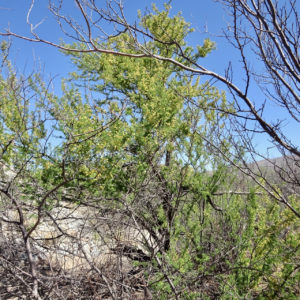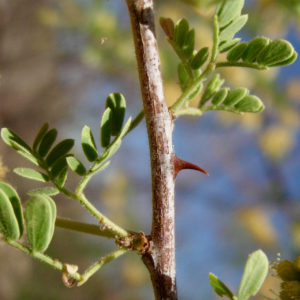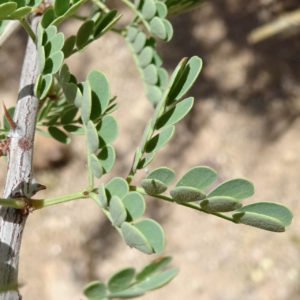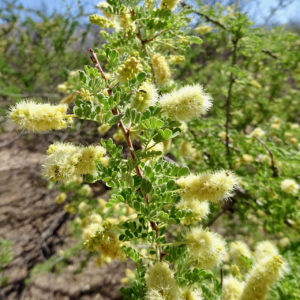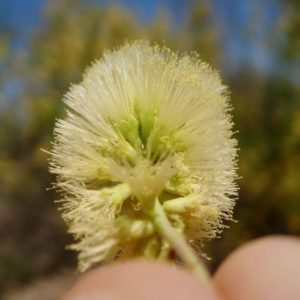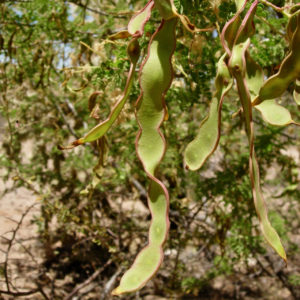Catclaw Acacia
Senegalia greggii
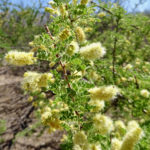
About the Plant
Catclaw acacia is a large shrub native to the Tucson area and the wider desert, into Mexico as well as New Mexico, Texas, and California. Almost always multi-stemmed, catclaw acacia can grow into a 20 foot tree if given ample moisture. Its long roots can reach groundwater when growing in washes. The prickles along the stems are shaped like cat's claws and can catch clothes and scratch skin, making this shrub inappropriate for tight spaces. Catclaw acacia works well, however, in naturalized plantings, as a purposeful barrier, and as a wildlife plant.
Catclaw acacia is a long-lived (100+ years) desert native that can survive on natural rainfall once established. Give it an occasional watering if the weather is especially hot and dry. The leaves are winter deciduous - and occasionally drought deciduous - so plan for its leafless state when designing your garden. The elongated, yellowish flower clusters appear mainly in late April and May. Grow catclaw acacia in full sun and well-drained soil. Prune (carefully!) only to remove wayward branches or to remove lower branches to expose the often attractive trunk.
Notes:
- Previous scientific name for this tree was Acacia greggii and you may still see it listed under this name.
- Another common name for catclaw acacia is wait-a-minute bush. You'll either need to wait a minute as you try to disentangle yourself from the claw-shaped prickles or you will be yelling "Wait a minute! Wait a minute!" to your hiking companions.
- The sharp cat's claws on this plant are not spines or thorns but prickles. Prickles are outgrowths of the bark. Spines are modified leaves and are found at nodes, often paired (e.g. those of ironwood). A thorn is a stiff, modified stem with a sharp point (e.g. those of littleleaf palo verde).
- Native peoples used catclaw acacia for food and medicine. The hard, durable wood was used to make digging sticks, cradle frames, and baskets. Its wood was also used to make the fork at the end of the long poles used to dislodge saguaro fruit for harvesting.
Wildlife value:
- Bees feeding on catclaw acacia make excellent honey. This shrub is important for a wide variety of insects - bees but also wasps, beetles, flies, and butterflies.
- Catclaw is browsed by deer, rabbits, and other desert mammals and is an important food source for Gambel's quail.
- The dense, prickly branch structure makes catclaw acacia an excellent choice for nest building and many birds, such as cactus wren, black-throated sparrows, and nighthawks, will nest in its branches. Others, including quail, will use it as a roost.
More Information
Weekly Plant on catclaw acacia
Ethnobotanical uses of catclaw acacia
ID Characteristics
Catclaw acacia is a large shrub that can be trained into a small tree. Shrubby forms often reach 6 feet high and wide while trees can reach as high as 20 feet with similar spread. It is usually multistemmed with an irregular shape.
The bark of catclaw acacia is grey, sometimes fissured or shredding. Single, curved prickles are found along the twigs between nodes (see Notes in column at left for discussion).
The leaves of catclaw acacia are alternate and bipinnate, about an inch long. Each leaf has 2 to 6 sections (most commonly 4) arranged opposite each other. Each section has 3 to 6 pairs of opposite leaflets, each leaflet no more than about 1/4 inch long. The petiole, which connects the sections to the stem, is often channeled on the upper side. There is often a small, dark gland at the base of the first section pair. Click on the photo above to enlarge to see these features.
The flowers are clustered together in a short, densely flowered cylinder, often several at the same node. The flowers at the base of the 2 inch cylinder open first.
Both the sepals and the petals are triangular and short. There are 30 to 90 stamens in each flower and these are the showy part of the flower, at 1/4 inch or more, they are much longer than the sepals and petals. The flowers (and the flower cluster) appear creamy white to yellow.
The fruit of catclaw acacia is flattened and often twisted. It can be as long as 6 inches and almost an inch wide and often has a reddish tinge.
